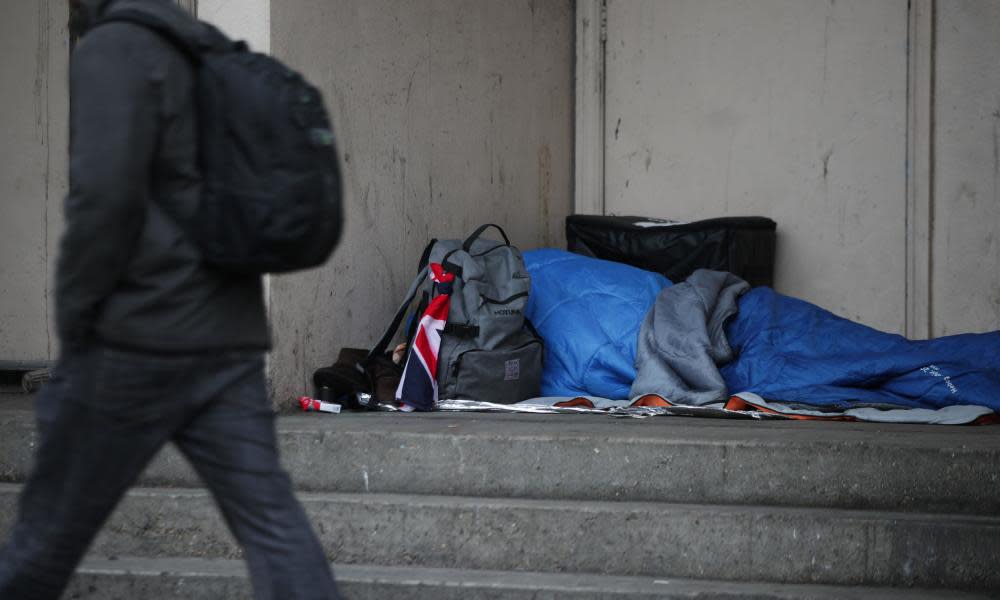Figures show soaring number of homeless hospital patients

Thousands of homeless people in England are arriving at hospital with Victorian-era illnesses such as tuberculosis, as well as serious respiratory conditions, liver disease and cancer, with hospital admissions for such conditions surging over a decade, the Guardian can reveal.
Austerity, cuts to vital welfare services and an ageing homeless population have been blamed for the dramatic surge in largely preventable illnesses, including a sevenfold rise in pneumonia and a tenfold increase in hepatitis C. Deaths in hospital and palliative care for homeless patients have also surged since 2008, NHS figures show.
The data, seen exclusively by the Guardian, has been described as a “huge underestimate” by experts, who say the majority of NHS hospitals and care centres are not equipped to treat homeless patients and record high-quality information about their care.
The vice-president of the Royal College of Emergency Medicine, Dr Chris Moulton, said the figures were “deeply disturbing”, but “not at all surprising in light of the people doctors see coming to A&E departments all over the UK”.
He said: “Homelessness is a national scandal that causes enormous health problems and suffering for those involved … It’s hard to send home someone who is ill but how do you send a homeless person who is ill home? That takes a certain degree of callousness.”
Moulton said the issue was putting a huge strain on the NHS. “The consequences on the NHS is expensive and long-term care for disability, alcoholism and mental health problems ... These figures are a sign of a lack of services, and a lack of attention to the problem.”
NHS data, which is believed to be a significant underestimate because trusts do not have an agreed definition of homelessness or require patients to record their housing status, shows admissions from people with “no fixed abode” soared from 1,539 in 2008-9 to 10,259 in 2017-18.
Hepatitis C admissions rose from 128 to 1,433 over the period, visits for diabetes went from 196 to 1,250 and alcoholic liver disease attendances rose fivefold from 135 to 521.
Deaths recorded at NHS hospitals more than quadrupled, rising from 18 to 95 in the last 10 years. Palliative care treatment from patients with no fixed abode rose from one in 2008-9 to 45 last year.
Reacting to the data, Dr Nigel Hewett, medical director of Pathway, which helps NHS trusts integrate care for homeless people into their services, said: “It is my fear that a doctor qualifying in 2019 will inevitably spend her entire professional career dealing with the health inequity arising from the austerity measures put in place since the 2008 crash. At least this time around we have built an evidence base and know what to do, if there is the will.”
His words were echoed by Dr Rosena Allin-Khan, the Labour MP for Tooting and an A&E doctor, who said: “It has been a tragedy to witness the rise in emergency department attendance and hospital admissions for the homeless.”
“This winter, waiting rooms have been brimming with people desperate for treatment for chest infections. Furthermore, whereas previously drug and alcohol support was more readily available, long referral times and no access to a fixed address has meant many are lost in the system and unable to receive help when they reach crisis point.”
Jon Sparkes, the chief executive at the homeless charity Crisis, said: “This just can’t carry on. When people have access to a stable home, they are far less likely to develop health problems.”
Experts put the rise in hospital attendances down to cuts to services and austerity. Critics of the government say local drug and alcohol teams are not getting the funding they need because of the squeeze on local authorities’ public health budgets, forcing more people to self-refer for costly treatment.
Steve Moffatt, the public policy manager at the drug charity Addaction, said the rise in deaths from alcoholic liver disease, drug-related deaths and hepatitis C reflects “the extent of a growing crisis”.
He said: “The number of homeless people has risen sharply, which increases demand on existing services. At the same time outreach services best equipped to reach this group are facing significant cuts, often where they’re most needed. It’s not surprising that more and more people are at crisis point.”

 Yahoo News
Yahoo News 
